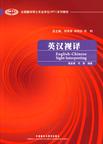英汉视译
出版时间:2009-3 出版社:外语教学与研究出版社 作者:秦亚青,何群 页数:414
Tag标签:无
前言
改革开放30年,助推中国翻译事业的大发展、大繁荣,勃勃生机,蔚为壮观。今天的翻译,无论在规模、范围上,还是在质量、水平上,以及对中国社会发展的贡献上都是史无前例的。随着我国经济持续、健康、快速的发展和改革开放的不断深入,我国综合国力不断增强,政治、经济、文化等各方面的国际交往日益频繁。作为服务于改革开放的先导力量和与世界沟通的桥梁,翻译的作用愈发突出。然而,在翻译需求不断攀升的同时,作为翻译人员主要培养阵地的高校,却日益暴露出其在翻译教学与实践之间的脱节问题。毕业生翻译技能不扎实,知识面狭窄,往往难以胜任不同专业领域所需的高层次翻译工作,致使翻译领域特别是高级翻译领域的供需矛盾日益突出,不能满足目前的经济和社会发展需要。这从数量上和质量上。都对高水平翻译人才的培养提出了迫切的要求。为适应我国改革开放和社会主义现代化建设事业发展的需要,促进中外交流,培养高层次、应用型高级翻译专门人才,国务院学位委员会2007年1月23日第23次会议审议通过设置翻译硕士专业学位(MTI)。翻译硕士专业学位是我国第1 8个硕士层次的专业学位,其设立无疑是继2006年教育部批准试办翻译本科专业后我国翻译学科建设取得的又一里程碑式的成果,为我国培养高层次、应用型、职业化的翻译人才提供了重要途径,为我国翻译学的学科发展奠定了基础,同时也给我国的外语学科发展带来了机遇与挑战。翻译硕士专业学位培养德、智、体全面发展,能适应全球经济一体化及提高国家国际竞争力的需要,适应国家经济、文化、社会建设需要的高层次、应用型、专业性口笔译人才。翻译硕士专业学位教育在培养目标、师资要求、教学内容以及教学方法和手段这四点上都与传统的翻译方向研究生教育有很大的不同。首先,翻译硕士专业学位教育注重对学生实践能力的培养,按口译或笔译方向训练学生的口笔译实际操作能力、跨文化交际能力,并为满足翻译实践积累所需要的百科知识。这一点与传统的外国语言文学学科中的翻译研究方向侧重培养学生的外国语言文学理论研究能力、学术研究能力以及就业为导向的教学能力的培养目标差别很大。第二,对学生实践能力的高要求和培养目标的应用型导向,也要求承担翻译硕士专业学位教学任务的教师必须具有丰富的口译或笔译实践经验,并了解翻译教学的原则。
内容概要
本书为翻译硕士专业学位(MTI)专业选修课教材。 视译应用范围广泛,常被视为同声传译的一种特殊形式,也被当作同传训练的一种基本方法。本书作为国内第一本系统传授视译技巧的专业教材,既有对视译原理、原则和基本要求的详细阐述,也有对视译中常用翻译技巧的实例讲解,具有很强的实践性和实用性,适用于专业教学和自主训练。主要特点如下: 教学设计循序渐进:从英汉两种语言转换的具体方法入手,由易到难讲授和训练各项视译技巧,为培养同传能力打下坚实基础; 训练素材真实广泛:选文涵盖政治、经济、文化、能源、环境、体育等国内外会议常见专题内容,视译译文真实再现译员现场表现; 技巧讲解注重实效:每单元突出一个重点,介绍不同句型在视译中常用的翻译技巧,对实用句型进行讲解,以大量实例进行示范; 视译练习丰富多样:各单元课堂实战练习与课后自主训练相辅相成,并配有参考译文,有助于学习者一步步巩固视译技巧,提高实战能力。
书籍目录
绪论第1单元 视译语序第2单元 视译单位第3单元 视译单位之间的衔接第4单元 定语的视译(Ⅰ):定语短语第5单元 定语的视译(Ⅱ):定语从句第6单元 同位语的视译第7单元 状语的视译(Ⅰ):状语短语第8单元 状语的视译(Ⅱ):状语从句第9单元 句子成分的转换第10单元 被动语态的视译第11单元 形容词和副词比较级的视译第12单元 It句式的视译第13单元 There+be句式的视译第14单元 长句的视译(Ⅰ)第15单元 长句的视译(Ⅱ)附录一 自主训练参考答案附录二 主要参考书目
章节摘录
插图:About this trip, what can you tell us now?Secretary: Well, he is very much looking forward to the APEC Meeting in Shanghaiand then from there to Beijing, and I think he wants to form a personalrelationship with President Jiang Zemin and the other leaders. President Bushvery much believes in getting to meet other leaders and to talk to them face to face and convey that American attitude of friendship and the American attitude of "let's see if we can work together to solve any problems that exist between us, and let's always be doing what we can to improve the relationship between our two countries". 3) So he is excited about coming to China. He is looking forward to it very, very much.Interviewer: Did he tell you anything before you left Washington?Secretary: He said to make sure that in my conversations with the Chinese leaders I conveyed what I just said——Washington is not in a confrontational mode. Why would we want to be in a confrontational mode? We are one of the best trading partners that China has. Forty percent of your products come to the United States. American consumers depend to a large extent on products that come from China to help them go about their lives. The products that come are at a reasonable cost. American businesses are investing in China. This is the basis for a positive relationship, a relationship that grows, not the basis for a confrontational relationship. The areas that we will have some difficulty with, and the President will be candid about this, have to do with human rights, and we do have some concerns about proliferation issues.But this isn't the only basis of our relationship. These are the things we are talking our way through.Interviewer: But it seems that here is a little confusion in terms of definitions of bilateral relations. For example, it seems to me that President Bush does not follow very much the idea of strategic partnership that was defined by our two governments a few years ago. While, at the same time we notice that just on the eve of your visit you said that the United States is not trying to view China as an enemy. So, Mr. Powell, between "partner" and "enemy", if I may ask you, which word would you like to choose?
编辑推荐
《英汉视译》由外语教学与研究出版社出版。
图书封面
图书标签Tags
无
评论、评分、阅读与下载
用户评论 (总计128条)
- 鉴于视译是同传的基础,所以决定先把这本书买下来看看怎么样,收到书后,发现质量很好,书中逻辑也很强,重点突出,每个单元讲解一个视译技巧,有例句分析,讲解每个分句如何视译,有时,这些视译的技巧完全可以应用到同传上面,材料也比较新,是本不错的视译训练的教材,唯一一个小小的缺点是后面的练习有点少,每单元后只有一个练习。所以在每次学习完上面讲解的视译技巧后,自己需要找大量材料来练习。是一本非常适合自学的书。
- 快递很给力,书的质量很好啊,一看就是正品,书里面对视译的翻译方法和翻译技巧介绍得很详细,有了它,相信自己的视译水平一定会有所提高。感谢作者,感谢当当,感谢快递员!
- 没买之前在图书馆大概翻了翻然后用第一张进行练习,觉得材料还是很丰富的,讲解与练习很多。不过大幅篇章视译练习后的参考答案主要还是调整过的翻译,不是按视译原则走的,不过也已经很好了~~~
- 这本书先是在图书馆看到的,读了差不多一半,然后决心买下来,虽然自己没有打算考翻译硕士,但是那种快速视译的方法值得学习。对于以后提高学习英语的效率应该很有帮助。
- 应该是讲视译最到位的一本,毕竟是MTI教材,如果练习的答案也能按照视译来翻就好了
- 视译是提高口译速度与准确率的基础,这本书很实用,针对性强,训练也多,主编还是新概念的中文主编何其莘,很不错啦!
- 这本书,让我明白和笔译和视译的区别,知道了视译要以顺译为基础,否则是难以进行下去的书上对"顺译"的可能性,操作性,分析相当的好,让我学到了许多的技巧,对工作帮助很大,在此,非常感谢!!!!!!!!!!!!!!
- 如果单从本书的教学内容来说,那可以算是国内第一本详细讲解“视译”过程的教科书了。而且每章后面都配有一定的练习,也很适合自学者使用。推荐。
- 国内唯一的视译教材,主编具有多年实战经验,内容具有很强的实用性,是老师强烈推荐的课本,下学期要用来上课的。
书的质量很好 - 讲得很不错,深入浅出,译文都不是笔译出来的,是真实的视译出来的
- 详细的从语法的角度介绍了视译的方法,对以前语法不好的人来说是个补充。书中还配有大量的练习,可以对所学知识进行巩固。强烈推荐。
- 对于正在学习翻硕,或者对英语翻译很感兴趣的人,这本书很好,视译是英语翻译重要的一项内容,当当的书不错,很新,也应该是正版,有些书还有满额减,很赞
- 我也是看了评论才买的。
是不是中国第一本教英汉视译的我不清楚。
但是书里的方法很好。
特别是最阅读也有帮助的。
毕竟你要快速阅读的话不可能做语法分析,分析来分析去,没那个时间。
以前我们学习外语的方式都是一篇不长的文章,老师讲单词讲语法,
一节课就讲了三四百字的文章,这样的阅读速度到了国外只有死路一条。
建议再买一本英语快速阅读的书籍,快速把握文章结构 - 英汉视译,是一种很好的方法,而且此书较为少见。
- 可以提高你的视译水平,提高口译技能。
- 此书非常好,以前没见过系统讲视译的教材,这本书确实超值
- 国内很少有视译专门的书,这本书不错
- 讲得很详细 后面有很多练习 对初次接触视译的人来说很有帮助
- 老师把视译一带而过了,这本书真的不错,各种方法都很全
- 很喜欢的一本视译书,讲的有条理,练习也好
- 这本书真是太好了!对学习视译的童鞋非常有帮助!内容详细、很好!
- 考北二外的时候复试有视译,我就是买的这本书。
- 书很好,就是不知道为什么不出汉英视译呢?
- 很不错的视译书籍!推荐!
- 学校指定教材 也没怎么用 有些提供的翻译版本太啰嗦 毕竟编的也是几年前的内容了 只能做基础训练吧
- 之前上口译课的时候,老师推荐的~~确实不错~~~
以前总是无法理解,现在倒不错~~~拨开云雾见青天啦~~~
嘻嘻,受益匪浅~~~ - 这些书是MTI的不二选择 挺实用的教材 全面细致
- 考英语翻译硕士必备良书,内容一般般,符合考试要求。
- MTI的课程没有固定教材,所以自己买了一本业余时间联系的。还不错吧~
- 很有用的书,口译必备,MTI必备!
- 到货快,实用,对有志于翻译的人是本好书。
- 这本书还是需要有一定翻译功底再度的
- 这不能书 非常不错 自己看了很受用 笔译要扎实 才能做好口译啊
- 教材用的 还不错了哦~ 有点点旧的内容 口译 变化多端
- 当当服务到位,书的质量很好,很好的额口译教材!
- 讲解不错,但是后面练习对应的答案不好
- 非常的专业和实用,对实际工作帮助很大!
- 发货送货速度快,纸张质量好,内容很专业!
- 这本书是老师规定我们要买的教材
- 很不错。终于买到教材了。
- 这是我们学校的指定用书,很好的教材
- 我的一个很棒的口译老师推荐的,果然不错~~就是题量少了哈~~
- 很少发表评论,由于这本书给我的触动太大,所以要出来冒个泡:)1。内容很新,不必多谈;2。设计合理,循序渐进;3。适合自学,章章独立;4。排版科学,赏心悦目;5。再接再厉,多处精品。
- 大一,准备考口译,书里内容实在
- 不愧为外研社的书,质量高,编排合理。我虽然还没看完,但是已经学到了不少东西。想从事口译的童鞋们,可以买来看看,不会失望的。
- 我已经学了几个单元,感觉很好。
- 这个系列的书都很好,推荐!
- 里边的内容都是循序渐进的,不管是上课 不管是课上用还是自学都很有帮助
- 第一印象挺不错的
- 质量很好,视频清晰,提高很快。
- 非常实用的一本书,发货速度也很快
- 很实用的一本书,很好!
- 里边的内容比较详细,看起来容易理解
- 讲的还比较实用
- 一本很实用的书..
- 开课了 这是全国统一教科书,还好吧
- 书本很好,但是本次配送慢了点,另外发现下单后两天价格更优惠了……郁闷
- 还可以,比较系统。
- 案例很多,方便参考
- 只是翻了一下,但从前言的介绍来看是本不错的书
- 同传的基础功底!
- 很大很厚的一本书 也没有压皱了 挺好
- 挺好的一本书,想考高翻,会很有用处
- 没有瑕疵,不错的一本书。
- 读了这本书就知道没有什么不可能的事,事在人为。
- 老师推荐的一本书,当当送货之后看了一下,确实不错。
- 纸质很好,质量很厚重,看起来很有质量,印刷也不错。内容很不错,坚持下去练会有效果的!
- 这个书是老师指定买的。下学期才学。粗粗看了下,纸张比较粗糙,字迹到清晰。不过重在内容。
- 书本纸质和印刷质量都很好,且内容编排非常合理,自学用的话也很好。
- 包装挺好,内容也还行。。。
- 赞!感觉还不错、适合学习
- 不错的书籍,有学习价值。
- 非常好的书,是正版。非常感谢当当,帮助爱读书,需要读书买书的人减轻负担,高质低价!
- 考试之前临时抱佛脚买的 超级有用当然考得也很好
- 很不错的书,最近在当当买了好多书呀~~都很实惠
- 这本难度好大~正品书~
- 书写的很好,自学也很有用。
- 复试用书,不评论
- 过来人推荐,真心好书!
- 。。好。。。。。
- 还没开始读。。但是的确很不错。。。
- 送货很快,书也很好,以后继续买
- 发货快,好的没话说。
- 很喜欢 好好学
- 送货很快,书也很好,非常开心
- 发货很快,书纸张好,更重要的是真的可以作为同传入门材料
- 要考试,看过考上北外高翻的人推荐的,买了一本,书纸的质量真不错!绝对正版
- 书质量很好 有用
- 很好的书,不过买错了
- 适合我读书的习惯,资料少了些
- 速度很快,质量很不错
- 要是配个碟就更好
- 书很好,这也是我们老师推荐的书。喜欢
- 书很好,看完就了不得啦
- 书很好,速度也很快!
- 正是想要的书。
- 包装不好 书都坏了
- 考研用的书,例子不错。
- 24节气送人的,其他书自己看,很好
- 为梦想加油吧,这些书都很好,非常喜欢!
推荐图书
- 中华人民共和国合同法案例解读本
- 中华人民共和国农村土地承包法案例解读本
- 中华人民共和国企业所得税法案例解读本
- 中华人民共和国消费者权益保护法案例解读本
- 中华人民共和国继承法案例解读本
- 物业管理条例案例解读本
- 商标权的法律保护与运用
- 职务犯罪立案标准与司法适用
- 法律与分歧
- 民商法研究(第8辑)
- 2010国家公务员录用考试行政职业能力经典集训
- 新型农村合作医疗制度的规范化与立法研究
- 精致胸花/爱上丝网花丛书
- 骑士幻想夜Ⅰ
- E数学(理)高3全/学海导航教学同步辅导
- 骑士幻想夜Ⅱ
- 进阶理解版式设计
- 卡通动漫屋①
- 对比色调配色宝典
- 名师高柏年
- 美术字与插图集/趣味新概念黑板报
- 快乐拼音测试卷二册
- 鲈鱼
- 童话@迷宫NO.1
- 蒙纸学画
